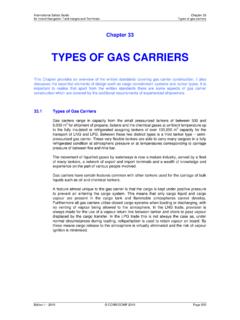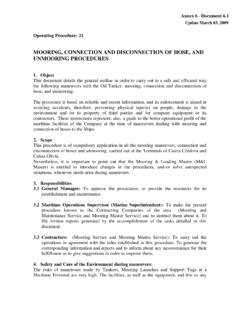Transcription of TERMINAL SYSTEMS AND EQUIPMENT - isgintt.org
1 International Safety Guide Chapter 17 for Inland Navigation Tank-barges and Terminals TERMINAL SYSTEMS and EQUIPMENT Edition 1 - 2010 CCNR/OCIMF 2010 Page 255 Chapter 17 TERMINAL SYSTEMS AND EQUIPMENT This Chapter describes EQUIPMENT that is provided by the TERMINAL at the tanker/shore interface, including fendering, lifting, lighting and bonding and earthing EQUIPMENT . Considerable emphasis is placed on ensuring that the tanker and shore remain electrically isolated, and on the means of achieving isolation. Electrical EQUIPMENT The classification of hazardous zones for the installation or use of electrical EQUIPMENT within a TERMINAL is described in Section Terminals should ensure that any electrical EQUIPMENT is provided in accordance with a site specific area electrical classification drawing, which shows hazardous zones at the berths in plan and elevation.
2 Terminals should identify the zones and establish the type of EQUIPMENT that is to be installed within each zone. National legislation, international standards and company specific guidelines, where available, are all to be complied with. A planned maintenance system should address the continued integrity of the EQUIPMENT installed, and ensure it remains able to meet zone requirements. Personnel carrying out maintenance on EQUIPMENT within hazardous zones should be trained and certified as competent to carry out the work.
3 Certification may be by internal process or as required by regulatory bodies. All electrical maintenance should be carried out under the control of a Permit to Work system (see Section ). Fendering Fendering SYSTEMS at each berth should be engineered to suit the range of tanker sizes and types that use the berth and should be capable of withstanding expected loads without causing damage to the tanker. The design should take account of the method of operating the berth. International Safety Guide Chapter 17 for Inland Navigation Tank-barges and Terminals TERMINAL SYSTEMS and EQUIPMENT Edition 1 - 2010 CCNR/OCIMF 2010 Page 256 In calculating the berthing energy to be absorbed by the fendering system, the speed at which a tanker closes with the berth is the most significant of all factors.
4 Energy is calculated as a function of mass and the square of the speed (E = mv2). (See Section ) The spacing of the fenders should allow the tanker to lie alongside, with the fenders on the parallel sides of the tanker, at all freeboards and all expected heights of the tide. The TERMINAL should advise tanker captains and berth operating personnel of the maximum permissible closing speed for each berth, recognising that this is often difficult to estimate. Lifting EQUIPMENT Inspection and Maintenance All EQUIPMENT used for the lifting of cargo transfer EQUIPMENT and/or means of access should be examined at intervals not exceeding one year and load tested at intervals not exceeding five years, or more frequently if mandated by local regulation or Company requirements.
5 EQUIPMENT to be tested and examined includes: Cargo hose handling cranes, derricks, davits and gantries. Gangways and associated cranes and davits. Cargo loading arm cranes. Store cranes and davits. Slings, lifting chains, delta plates, pad eyes and shackles. Chain blocks, hand winches and similar mechanical devices. Personnel lifts and hoists. Tests should be carried out by a suitably qualified individual or authority and the EQUIPMENT should be clearly marked with its Safe Working Load (SWL), identification number and test date. Terminals should ensure that all maintenance is carried out in accordance with manufacturers guidelines and that it is incorporated into the TERMINAL s planned maintenance system.
6 If certified EQUIPMENT is modified or repaired, it should be re-tested and certified prior to being placed back in service. Defective EQUIPMENT should be withdrawn from service immediately and only reinstated after repair, examination and, where required, re-certification. Training in the Use of Lifting EQUIPMENT All personnel engaged in operating lifting EQUIPMENT should be formally trained in its use. International Safety Guide Chapter 17 for Inland Navigation Tank-barges and Terminals TERMINAL SYSTEMS and EQUIPMENT Edition 1 - 2010 CCNR/OCIMF 2010 Page 257 Lighting Terminals should have a level of lighting sufficient to ensure that all tanker/shore interface activities can be safely conducted during periods of darkness.
7 Lighting levels should meet national or international engineering standards as a minimum. Particular consideration should be given to lighting of the following areas: Berth or jetty-head working areas. Access routes. Berth or jetty perimeters. Boat landings. Mooring dolphins and walkways. Stairways to elevated gantries. Emergency escape routes. Lighting of water around berth to detect spillage and possibly unauthorised craft. Tanker/Shore Electrical Isolation General Due to possible differences in electrical potential between the tanker and the berth, there is a risk of electrical arcing at the manifold during connection and disconnection of the shore hose or loading arm.
8 To protect against this risk, there should be a means of electrical isolation at the tanker/shore interface. This should be provided by the TERMINAL . It should be noted that the subject of tanker-to-shore electric currents is quite separate from static electricity, which is discussed in Chapter 3. Tanker-to-Shore Electric Currents Large currents can flow in electrically conducting pipework and flexible hose SYSTEMS between the tanker and shore. The sources of these currents are: Cathodic protection of the jetty or the hull of the tanker provided by either an impressed current system (Impressed Current Cathodic Protection - ICCP) or by sacrificial anodes.
9 Stray currents arising from galvanic potential differences between tanker and shore or leakage effects from electrical power sources. An all metal loading or discharge arm provides a very low resistance connection between tanker and shore and there is a very real danger of an incendive arc when the ensuing large current is suddenly interrupted during the connection or disconnection of the arm at the tanker manifold. Similar arcs can occur with flexible hose strings containing metallic connections between the flanges of each length of hose. International Safety Guide Chapter 17 for Inland Navigation Tank-barges and Terminals TERMINAL SYSTEMS and EQUIPMENT Edition 1 - 2010 CCNR/OCIMF 2010 Page 258 To prevent electrical flow between a tanker and a berth during connection or disconnection of the shore hose or loading arm, the TERMINAL operator should ensure that cargo hose strings and metal arms are fitted with an insulating flange.
10 An alternative solution with flexible hose strings is to include, in each string, one length only of non-conducting hose without internal bonding. The insertion of such a resistance completely blocks the flow of stray current through the loading arm or the hose string. At the same time, the whole system remains earthed, either to the tanker or to the shore. All metal on the seaward side of the insulating section should be electrically continuous to the tanker; all metal on the landward side should be electrically continuous to the jetty earthing system.





